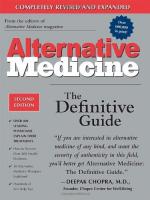|
This section contains 7,386 words (approx. 25 pages at 300 words per page) |

|
The National Center for Complementary and Alternative Medicine (NCCAM), an institute of the National Institutes of Health (NIH), was created in 1992 because consumers of complementary and alternative medicine (CAM) and health care practitioners wanted to know whether available alternative medical options are safe and effective. NCCAM is "committed to the clinical study of promising CAM substances and modalities before knowledge becomes available about their active ingredients, mechanisms of action, stability, and bioavailability," and the organization uses a hierarchy of evidence to determine a method or product's effectiveness and safety. Studies indicate that data on the efficacy and safety of CAM therapies span a continuum ranging from anecdotes and case studies through encouraging information obtained from large, well-developed clinical trials. (See Figure 9.1.)
NCCAM defines alternative medicine as "a group of diverse medical and health care systems, practices, and products that are not presently considered to be part...
|
This section contains 7,386 words (approx. 25 pages at 300 words per page) |

|


